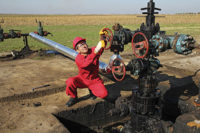Oil boom of 2003-2013: Workforce growth rate far outpaced fatality rate

During 2003–2013, the U.S. oil and gas extraction industry experienced unprecedented growth, doubling the size of its workforce and increasing the number of drilling rigs by 71%. To describe fatal events among oil and gas workers during this period, NIOSH analyzed data from the Bureau of Labor Statistics (BLS) Census of Fatal Occupational Injuries (CFOI), a comprehensive database of fatal work injuries.
During 2003–2013, the number of work-related fatalities in the oil and gas extraction industry increased 27.6%, with a total of 1,189 deaths; however, the annual occupational fatality rate significantly decreased 36.3% during this 11-year period. Two-thirds of all worker fatalities were attributed to transportation incidents (479, [40.3%]) and contact with objects/equipment (308 [25.9%]). More than 50% of persons fatally injured were employed by companies that service wells (615 [51.7%]). It is important for employers to consider measures such as land transportation safety policies and engineering controls (e.g., automated technologies) that would address these leading causes of death and reduce workers' exposure to hazard).
Publicly available data from CFOI were used to determine the number of fatal injuries to workers in the U.S. land-based and offshore oil and gas extraction industry during 2003–2013. CFOI collects information from multiple data sources to identify, verify, and describe fatal work injuries. According to CFOI, a fatal injury is considered work-related if 1) the event leading to the injury occurred while the employee was working and 2) the event is verified by at least two independent data sources.* The North American Industry Classification System (NAICS) was used to identify fatal events among the three types of companies in the oil and gas extraction industry: oil and gas operators that control and manage leased areas (NAICS 211), drilling contractors that drill the wells (NAICS 213111), and well-servicing companies that provide all other types of support operations that prepare a well for production and completion (NAICS 213112).
Annual occupational fatal injury rates were calculated using worker estimates from the BLS Quarterly Census of Employment and Wages. Annual and overall fatality rates were also calculated by event type according to the Occupational Injury and Illness Classification System and by company type using NAICS. Negative binomial regression was used to estimate rates. The percent rate of change, incident rate ratio, and corresponding confidence intervals were calculated for the 11-year period, the five most frequent fatal events, and by company type. Each company and event type represents separate regression models.
During 2003–2013, 1,189 oil and gas extraction industry employees died while working, resulting in an average of 108 deaths per year and an annual average occupational fatality rate of 25.0 deaths per 100,000 workers. The highest fatality rate occurred in 2006 (32.4 deaths per 100,000 workers) with 125 fatalitie). During this period all but 10 decedents were male, and the largest numbers of deaths were to workers aged 25–34 years (331 [27.8%]). Most were non-Hispanic whites (844 [71.0%]). Two-thirds of the fatalities were attributed to transportation incidents (479 [40.3%]) and contact with objects/equipment (308 [25.9%]). Incidents on land (as opposed to air or water) made up 86.2% of the transportation events.
The remainder of the most frequent events were the result of fires or explosions (170, [14.3%]); exposure to harmful substances or environments (105 [8.8%]); or falls, slips, and trips (97 [8.2%]). The largest number of fatalities occurred among workers employed by well-servicing companies (615), followed by drilling contractors (378), and operators (196); but the highest fatality rate was among workers employed by drilling companies (44.6 per 100,000 workers), followed by well-servicing companies (27.9), and operators (11.6).
Although the oil and gas extraction industry's number of occupational fatalities increased 27.6% during the 11-year period, it did not increase as much as the number of workers, resulting in a significant decrease in the fatality rate of 36.3%. The average annual decrease was 4% per year. Oil and gas operators experienced the largest decrease in the rate of fatal injuries, 8% per year, followed by well-servicing companies (4% per year). Among event types, contact with objects/equipment experienced the greatest decrease, 9% per year; transportation events also showed a significant decrease, 3% per year .
Previous research found a positive correlation between the level of activity (number of active drilling rigs) and the occupational fatality rate in the U.S. oil and gas extraction industry. This report found that although the number of active drilling rigs increased by 71% and the number of oil and gas extraction workers more than doubled during 2003–2013, the industry's fatality rate significantly decreased.
Transportation events and contact with objects/equipment events were the most frequent fatal events in the oil and gas extraction industry, which is consistent with previously reported data. This analysis showed the rate of fatalities caused by contact with objects/equipment experienced the greatest decrease during 2003–2013, which might be related to the increased use of automated technologies on drilling rigs such as hydraulic catwalks to move drill pipe from ground level to the rig floor and powered tongs used to make and break drilling pipe connections. A recent study found lower non-fatal injury rates on rigs with automated technologies designed to reduce workers' exposure to hazardous equipment.
The report also found that the transportation-related fatality rate decreased significantly despite an increase in the number of fatalities. Previous research showed the majority of transportation fatalities were the result of motor vehicle crashes killing occupants of light trucks (e.g., pickup trucks), which are largely unregulated. Transportation fatalities did not include deaths while commuting to and from work, as these are not typically considered work-related. However, frequent long distance commutes are common for workers in this industry and are an area of concern.
This report is subject to at least three limitations. First, it would have been preferable to calculate fatality rates using estimates of the number of full-time equivalent workers, which takes overtime into consideration, but these estimates were not available for this industry. Second, changes made to the Occupational Injury and Illness Classification System for years 2011 and later are considered a break in series. Although event-type categories reported here did not undergo significant change in 2011, clarifications in the order of precedence for the event type categories were issued that might have led to differences in event coding starting in 2011. Lastly, fatal event numbers for 2013 are preliminary and might be incomplete. Historically, transportation event data are the most incomplete, and this could affect the trend.
Source: NIOSH
Looking for a reprint of this article?
From high-res PDFs to custom plaques, order your copy today!





